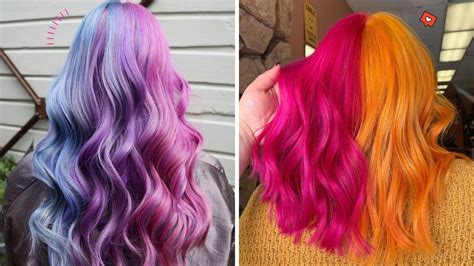Split hair dye, a captivating trend that has taken the fashion world by storm, allows you to experiment with multiple hues in a single hairstyle. This bold and eye-catching technique involves dividing your hair into two distinct sections, each showcasing a different color. The result is a mesmerizing visual statement that turns heads wherever you go.

History of Split Hair Dye
The origins of split hair dye can be traced back to the vibrant counterculture of the 1980s, where it gained popularity among punk and new wave enthusiasts. During this era, bold and unconventional fashion choices were celebrated, and split hair dye emerged as a symbol of individuality and rebellion. In recent years, this trend has experienced a resurgence, becoming a mainstream staple in both fashion and beauty.
Types of Split Hair Dye
The possibilities for split hair dye are endless, offering a vast array of styles and color combinations to suit every taste. Here are a few popular variations:
- Horizontal Split: The hair is divided horizontally into two sections, with one color on top and the other on the bottom.
- Vertical Split: The hair is divided vertically into two sections, creating a striking contrast between the colors.
- Diagonal Split: The hair is divided diagonally, resulting in a more dynamic and edgy look.
- Asymmetrical Split: The hair is divided into two uneven sections, offering a unique and asymmetrical design.
Benefits of Split Hair Dye
Split hair dye offers numerous benefits that make it an attractive choice for both fashion-forward individuals and those seeking a change in appearance:
- Versatility: Split hair dye can be customized to complement any hair length, texture, and style.
- Expression of Individuality: It allows you to express your personality and creativity through color.
- Low Maintenance: Despite its bold appearance, split hair dye is relatively low maintenance, as only the roots need to be touched up regularly.
- Temporary Transformation: Split hair dye is a temporary way to change your hair color without committing to a permanent alteration.
Choosing the Right Colors
Selecting the right colors for your split hair dye is crucial to achieving a stunning and cohesive look. Here are a few tips:
- Consider Your Skin Tone: Cool skin tones tend to look best with cool-toned colors, while warm skin tones complement warm-toned colors.
- Experiment with Contrasting Hues: Pairing contrasting colors, such as black and white or blue and orange, creates a striking and dramatic effect.
- Choose Colors That Enhance Your Eyes: Select colors that complement the color of your eyes to highlight them and make them pop.
- Opt for Complementary Colors: Complementary colors, such as blue and orange or red and green, create a visually appealing balance.
Tips for Split Hair Dye
- Use Temporary Hair Color: If you’re unsure about a permanent color change, consider using temporary hair color to experiment with different shades.
- Bleach Your Hair First: Bleaching your hair before applying the split hair dye can help achieve more vibrant and vivid colors.
- Section Your Hair Carefully: Divide your hair into distinct sections using clips or bobby pins to ensure precision.
- Apply the Color Evenly: Use a brush or comb to distribute the hair color evenly throughout each section.
- Protect Your Hands: Wear gloves to prevent the hair color from staining your hands.
FAQs
1. Can I dye my hair split at home?
Yes, it is possible to dye your hair split at home, but it requires careful preparation and precision. It’s recommended to consult with a professional hairstylist if you’re unsure about the process.
2. How long does split hair dye last?
The longevity of split hair dye depends on the type of hair color used. Temporary hair color typically lasts a few washes, while permanent hair color can last up to several months.
3. What hair types are suitable for split hair dye?
Split hair dye can be applied to all hair types, including straight, curly, and wavy hair. However, it’s important to note that bleached hair tends to hold color better than unbleached hair.
4. Can I split hair dye my hair without bleaching it?
You can split hair dye your hair without bleaching it, but the results may not be as vibrant as with bleached hair. Bleaching helps open up the hair cuticles, allowing the color to penetrate more deeply.
5. Is split hair dye damaging to my hair?
Like all hair dyes, split hair dye can cause some damage to the hair. However, the extent of damage depends on the type of hair color used and the frequency of application. Using a deep conditioner and protective hair products can help minimize damage.
6. How do I choose the right color combination for split hair dye?
When choosing a color combination for split hair dye, consider factors such as your skin tone, eye color, and personal style. Experiment with different colors and consult with a hairstylist for professional advice.
7. What is the difference between split hair dye and dip-dye?
Split hair dye involves dividing the hair into two distinct sections and applying different colors to each section. Dip-dye, on the other hand, involves immersing the ends of the hair in a different color, creating a subtle ombré effect.
8. Is split hair dye a good choice for short hair?
Split hair dye can be a great choice for short hair, especially if you want to create a bold and edgy look. However, it’s important to choose a color combination that complements the length and style of your hair.
